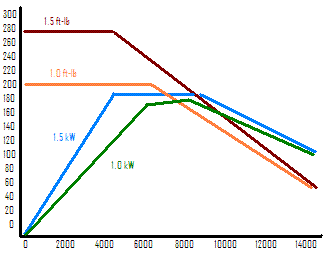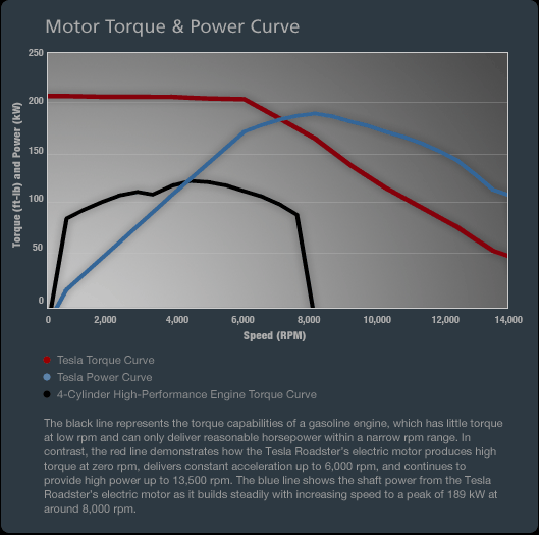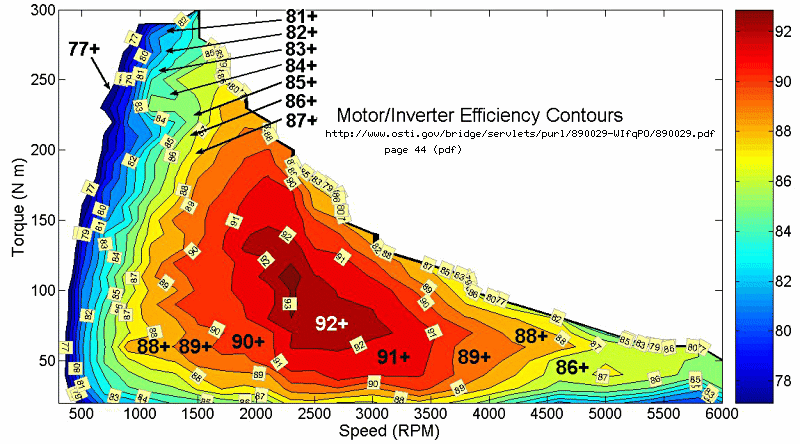Welcome to Tesla Motors Club
Discuss Tesla's Model S, Model 3, Model X, Model Y, Cybertruck, Roadster and More.
Register
Install the app
How to install the app on iOS
You can install our site as a web app on your iOS device by utilizing the Add to Home Screen feature in Safari. Please see this thread for more details on this.
Note: This feature may not be available in some browsers.
-
Want to remove ads? Register an account and login to see fewer ads, and become a Supporting Member to remove almost all ads.
You are using an out of date browser. It may not display this or other websites correctly.
You should upgrade or use an alternative browser.
You should upgrade or use an alternative browser.
My guess (and purely a wild guess) is that the PEM keeps improving incrementally over time. I bet the "drivetrain 1.5" chart looks even better than the 3 posted below. The sense I get from the townhall meeting chatter is that the PEM is now able to offer substantially more low speed torque to help achieve the 4s 0-60 even with one gear.
When I tried to investigate the ESS, PEM and eMotor limits a long while back the best info I could get was "eMotor heat is #1 limitation" followed by battery durability and then finally PEM limits. Apparently they came up with ways to cool the eMotor better, so then they got to PEM limits, and then have found new IGBTs to improve the PEM. This still leaves me wondering if the battery durability could now become an issue.
Maybe they have newer batteries that are happy doing sustained discharge above 4C? I don't expect Tesla to keep telling us web weenies every little engineering improvement they make. Substituting different cells shouldn't affect any of the crash results and such. Minor component substitutions in the PEM shouldn't either. Neither should adjustments in the cooling fins in the eMotor.
So, I expect the published torque chart will get even better someday. And I assume that Tesla will have worked out all the "balancing act" details to make sure that the eMotor doesn't overheat, and the batteries last long enough.
When I tried to investigate the ESS, PEM and eMotor limits a long while back the best info I could get was "eMotor heat is #1 limitation" followed by battery durability and then finally PEM limits. Apparently they came up with ways to cool the eMotor better, so then they got to PEM limits, and then have found new IGBTs to improve the PEM. This still leaves me wondering if the battery durability could now become an issue.
Maybe they have newer batteries that are happy doing sustained discharge above 4C? I don't expect Tesla to keep telling us web weenies every little engineering improvement they make. Substituting different cells shouldn't affect any of the crash results and such. Minor component substitutions in the PEM shouldn't either. Neither should adjustments in the cooling fins in the eMotor.
So, I expect the published torque chart will get even better someday. And I assume that Tesla will have worked out all the "balancing act" details to make sure that the eMotor doesn't overheat, and the batteries last long enough.
W8MM
R1.5 #325 + Mdl S #01380
When I tried to investigate the ESS, PEM and eMotor limits a long while back the best info I could get was "eMotor heat is #1 limitation" followed by battery durability and then finally PEM limits. Apparently they came up with ways to cool the eMotor better, so then they got to PEM limits, and then have found new IGBTs to improve the PEM. This still leaves me wondering if the battery durability could now become an issue.
I've been watching the progress of the e-motor/controller as well. The maximum torque (performance?) could very well be heat limited, and remain so, even if better cooling is found.
One way to jack up the maximum torque might be to make the PEM even more closely follow e-motor thermal conditions. One might arrange for the the PEM to pound lots of extra current into the e-motor, while keeping an eagle-eye on the thermal safety limit. The PEM might servo-control the e-motor maximum current in accordance with its housing temperature. This way, really quick acceleration is available for a few hammer-down 0-60 runs or a single quarter mile run before the PEM cuts back on the juice to prevent an over-temp "flame-out".
The current PEM already cuts back on maximum torque (as a thermal safety valve) in long-duration high-output driving situations, making it less than perfect as a track car. One could merely exaggerate the peak-to-average factor of this protection mode to deal with a much higher peak load for the e-motor with only modest cooling improvements.
Perhaps the new cooling improvements have the effect of increasing the thermal inertia of the e-motor (higher mass cooling components), besides lowering the thermal impedance to the atmosphere. Increased thermal inertia might give a little extra time to soak up waste heat while the e-motor housing temperature heads toward the trip point of the PEM thermal safety limiter.
Single speed tranny = just as quick, but for a shorter period of time?
Elon spilled quite some bins. They have eMotors running over 20.000 rpm in the labs. Add liquid cooling to that and you have some serious power 
Batteries are expected to last 500 to 700 deep-charge cycles. He mentioned 3.9s 0-60 time again, top speed limited to 130mph.
Batteries are expected to last 500 to 700 deep-charge cycles. He mentioned 3.9s 0-60 time again, top speed limited to 130mph.
They have eMotors running over 20.000 rpm in the labs.
Batteries are expected to last 500 to 700 deep-charge cycles. He mentioned 3.9s 0-60 time again, top speed limited to 130mph.
A torque projection for drivetrain 1.5 was the main "spilled beans" that I heard.
I don't remember all the sources, but I had already heard these before:
* 500-700 cycles on batteries
* 3.9s 0-60 target
* top speed around 130 (for drivetrain 1.0... perhaps more like 125 for 1.5)
* eMotor spun up over 18,000 RPMs on the dyno.
(It may not be reliable, practical, safe and/or useful to spin it this fast).
Due to various limits (on ESS/PEM/eMotor) they have to drop the torque as the RPMs rise past about 7000. At the current 13,000RPM redline the HP is already starting to drop off. Running the eMotor up to 18,000RPMs might not offer any performance advantage.
Elon also mentioned a 14,000RPM redline for his car (P1), but I thought that the specs were 13,000RPM redline. Could his car have special firmware that lets it "go to 11"?
W8MM
R1.5 #325 + Mdl S #01380
Running the eMotor up to 18,000RPMs might not offer any performance advantage.
It's hard to tell without seeing a speed vs. drag curve for the Roadster.
If the eMotor has enough horsepower to overcome the wind drag, it can rev on forever. When available horsepower finally diminishes to equal drag, then top speed is established.
Look at those torque charts at the beginning of this post. At 14,000RPMs HP has already dropped to around 100, and is falling fast. At 130+ MPH I think you are going to need that kind of power to hold the speed, so I still think that simply allowing a higher redline isn't going to improve the top speed.
Besides, just because the eMotor could rev past 16,000RPMs doesn't mean the gearbox could handle it!
Besides, just because the eMotor could rev past 16,000RPMs doesn't mean the gearbox could handle it!
They should use HP to be able to compare the curves to their piston engine competition.
They should also pick a piston engine comparison that is in the same peak HP range as well. otherwise, its a little misleading in my opinon.
They should also pick a piston engine comparison that is in the same peak HP range as well. otherwise, its a little misleading in my opinon.
Still waiting for Tesla to publish a 1.5 power/torque graph, but I suspect it may compare something like so:

flabby
Member
Does anyone know if there is an actual efficiency curve published for the Tesla motor, or for any AC or AC vs DC motor. By efficiency curve, I mean a plot showing energy efficiency of the motor vs the motor's rotational speed? Actual data, not theroetical.
Last edited:
Sill a little misleading. They finally quoted and compared to a comparable piston engine. I wonder if it was from my posts?
After all, its HP that will determine the "Torque" at the rear wheels at any vehicle speed.
Now, the curves are still very inaccurate. look at the tesla torque and power curve. they are actually incorrect at the lower motor speeds. check out torque of 300 vs engine speed of 2000rpm.
After all, its HP that will determine the "Torque" at the rear wheels at any vehicle speed.
Now, the curves are still very inaccurate. look at the tesla torque and power curve. they are actually incorrect at the lower motor speeds. check out torque of 300 vs engine speed of 2000rpm.
Glad they ~finally~ updated that... About time.
Last edited:
Ben W
Chess Grandmaster (Supervised)
Now, the curves are still very inaccurate. look at the tesla torque and power curve. they are actually incorrect at the lower motor speeds. check out torque of 300 vs engine speed of 2000rpm.
Power, why do you say that's incorrect? It looks right to me.
Now, the curves are still very inaccurate. look at the tesla torque and power curve. they are actually incorrect at the lower motor speeds. check out torque of 300 vs engine speed of 2000rpm.
From the chart we see that torque is ~300lb-ft from 0-~5000RPM.

At 2000rpm, using T=5252xHP/rpm we get 300=5252xHP/2000 or HP=~115.
Looking at the graph going up from ~2000RPMs I get about 85kW which is ~115hp.
So, the graph looks correct to me and checks out at 2000rpms.
Perhaps you forgot to convert kW to HP?
I think my old guesstimate wasn't too far off (note red and blue lines for 1.5):

The shape of the torque and HP curves were pretty close, but I was a bit low across the board. I was conservative because I averaged between the 288hp quotes and some other that said still 248hp but with more low end torque.
Similar threads
- Replies
- 41
- Views
- 1K
- Replies
- 3
- Views
- 413
- Replies
- 2
- Views
- 275










